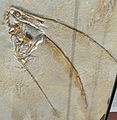Rhamphorhynchus
Rhamphorhynchus ("beak-snout") was a genus of long-tailed pterosaurs from the Upper Jurassic. Fossils were found at Tendaguru in Tanzania, in England as well as in the Nusplinger Plattenkalk in Württemberg and near Solnhofen and Eichstätt in Bavarian Franconia. In the Bavarian Plattenkalks Rhamphorhynchus is the most common pterosaur. Some of the specimens are so well preserved that the flight skin can still be seen. As with all original forms, Rhamphorhynchus still possessed a long tail, stiffened by ligaments, with a diamond-shaped skin sail at its end to aid in steering.
Rhamphorhynchus bore 20 relatively large, forwardly directed teeth in the upper jaw and 14 in the lower jaw, which interlocked alternately when the jaw was closed. Based on this dentition, most species were probably fish eaters; one specimen from Solnhofen still had remains of its last fish meal. The skulls of the specimens found have lengths between 3 (R. longicaudus) and 19 centimeters (R. longiceps). The wingspan is between 40 centimetres and 1.75 metres (R. longiceps).
·
R. muensteri from Solnhofen with impressions of the flight skin in situ
· 
R. gemmingi, live reconstruction
· 
A predator of the genus Aspidorhynchus catches a Rhamphorhynchus
Questions and Answers
Q: What is Rhamphorhynchus?
A: Rhamphorhynchus is a genus of long-tailed pterosaurs in the Upper Jurassic.
Q: What is the sub-order of Rhamphorhynchus?
A: Rhamphorhynchus belongs to the sub-order Rhamphorynchoidea.
Q: What is the function of the small diamond-shaped rudder on the end of Rhamphorhynchus' tail?
A: The small diamond-shaped rudder on the end of Rhamphorhynchus' tail helped keep it stable when it was flying.
Q: What was the diet of Rhamphorhynchus?
A: The diet of Rhamphorhynchus was mainly fish and insects.
Q: What is the body covering of Rhamphorhynchus and what does this suggest?
A: Rhamphorhynchus' body was covered in hairs, which suggests it had temperature regulation and a high rate of metabolism that was necessary for active flight.
Q: What is the significance of the Solnhofen limestone beds in Bavaria, Germany?
A: The Solnhofen limestone beds in Bavaria, Germany are significant because they are the same strata where Archaeopteryx was found, and Rhamphorhynchus is the most common pterosaur found there.
Q: Did Rhamphorhynchus have teeth on its beak-like tip?
A: No, Rhamphorhynchus had needle-like teeth angled forward, with a curved, sharp, beak-like tip lacking teeth.
Search within the encyclopedia
